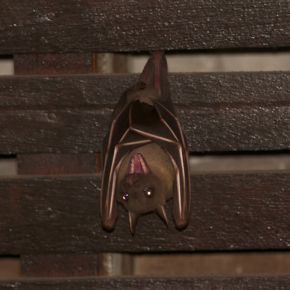The Common Fruit Bat (Cynopterus brachyotis) is a mammal and has the capacity of true flight – unlike flying squirrels and flying lemurs that actually are gliders. Its face is dog-like (above)
Like other bat species, it hangs on one or both feet when at rest with the help of its sharp, recurved claws at the tip of the five toes (below). With the head hanging down, it can suddenly launch into flight by releasing its grip on the hanging surface.
The thumb, with a sharp claw at the end, is used for food manipulation, clinging to surfaces or in crawling. It is also used in grooming.
The sharp pair of ears, with their concentric folds(?) on the inner surface, are thought to help in sound reception (above left). They regularly twitch when the bat is roosting, except when it is totally at rest. Note the long red tongue, usually covered with papillae (hairs) at the tip to help in mopping up nectar LINK as well as in grooming (above right).
YC Wee
Singapore
August 2014


![CFBat-face [wyc] - 1](https://besgroup.org/wp-content/uploads/CFBat-face-wyc-1.jpg)
![CFBat [wyc] 1](https://besgroup.org/wp-content/uploads/CFBat-wyc-1.jpg)

![CFBat-janging 2 feet [wyc] 3](https://besgroup.org/wp-content/uploads/CFBat-janging-2-feet-wyc-3.jpg)

![CFBat-roost-tongue [wyc] 6](https://besgroup.org/wp-content/uploads/CFBat-roost-tongue-wyc-6.jpg)







2 Responses
The picture of its open mouth is interesting – I’d like to take a closer look at their teeth. Was the bat opening its mouth to call? P.S. Have tons of BESG posts to catch up on!
Did not hear any sound with the opening of the mouth to show the teeth.